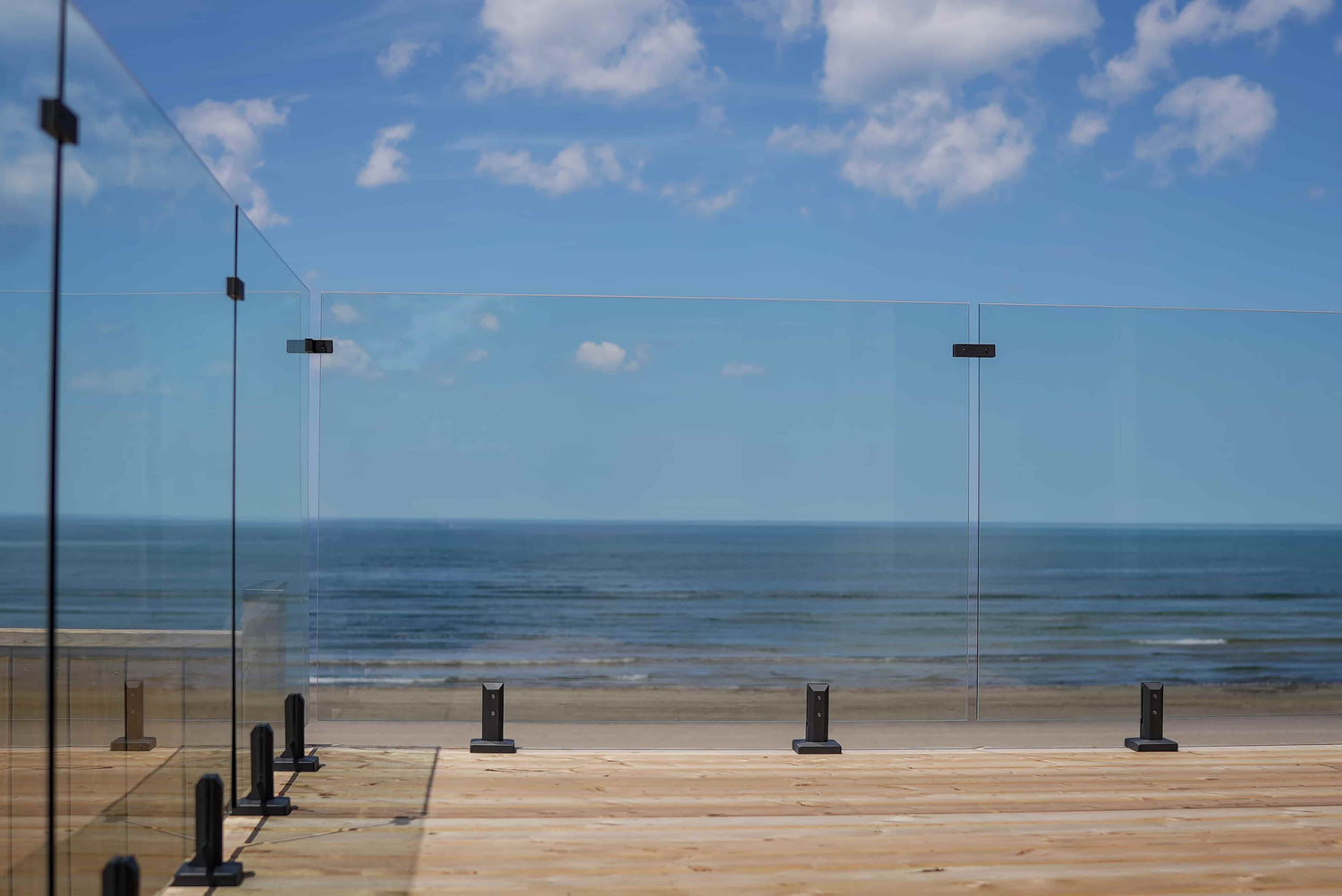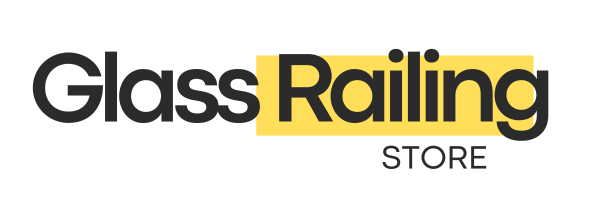Wisconsin Building Code for Glass Railings

The varied terrain of Wisconsin presents special difficulties for the construction of glass railings, from the coasts of Lake Superior at 601 feet above sea level to the summit of Timms Hill at 1,951 feet. The Badger State requires close attention to building code compliance since it includes Driftless Area lowlands, Central Plain farmlands, and Northern Highland woods.
The Wisconsin Department of Safety and Professional Services (DSPS) is in charge of overseeing the state's dual building code system. While residential buildings adhere to the Wisconsin Uniform Dwelling Code (UDC) under chapters SPS 320-325, commercial buildings must comply with the 2021 International Building Code (IBC) as of September 1, 2025.
Understanding Wisconsin's Building Code Framework
Wisconsin's dedication to safety standards through DSPS monitoring is reflected in the state's building code system. Wisconsin has moved closer to international building standards with the recent adoption of the 2021 IBC for commercial structures, the first significant change in ten years. One- and two-family homes are governed by the Uniform Dwelling Code, whereas multi-family residential buildings and commercial structures are governed by the Wisconsin Commercial Building Code. Because the criteria for glass railing installations differ greatly between various legal regimes, this distinction is essential.
DSPS Administration and Recent Updates
In Wisconsin, DSPS is in charge of professional licensing, code adoption, and safety enforcement. The 2025 implementation comes after legislative attempts to thwart code modernization were defeated by the Wisconsin Supreme Court in the Evers v. Marklein case. Professional glass railing systems must understand these dual code requirements and ensure compliance with appropriate regulations based on building type and occupancy classification. According to the National Association of Home Builders, proper code compliance protects both property owners and contractors from liability issues while ensuring occupant safety.
Glass Railing Safety Requirements and Standards
IBC Section 2407 for commercial applications and UDC rules for residential installations are the main focuses of Wisconsin's glass railing safety regulations. In both code systems, all glass railings must have safety glazing that satisfies either Class A (ANSI Z97.1) or Category I (16 CFR 1201) requirements. According to load requirements, glass railings must be able to support a uniform weight of 50 pounds per linear foot applied horizontally along the top rail, in addition to a 200-pound concentrated load applied at any location and direction. These specifications are the same for both residential and commercial uses in Wisconsin.
Material Performance Standards
The framework for evaluating railing systems' strength, impact performance, and post-breakage characteristics is provided by ASTM E2353 test procedures. A 4x safety factor, or permissible stresses equivalent to one-fourth of the material's full strength, must be incorporated into glass components. Laminated glass construction with ethylene vinyl acetate (EVA) or polyvinyl butyral (PVB) interlayers is the norm for contemporary glass railing systems. The exceptional post-breakage performance of these materials is especially crucial in light of Wisconsin's severe temperatures.
Quality glass railing installations designed for Wisconsin's climate incorporate features that handle freeze-thaw cycles, thermal expansion, and seasonal temperature variations. The American Architectural Manufacturers Association provides guidelines for installations in climates with significant temperature variations, ensuring long-term performance.
Height and Dimensional Requirements
Clear height standards that differ for residential and commercial purposes are established by Wisconsin's building regulations. Under the 2021 IBC, commercial buildings must have guard heights of at least 42 inches above nearby walking surfaces; under the UDC, residential applications are permitted to have guard heights of 36 inches. Guards are required for any walking surface that is more than 30 inches above the ground, such as raised patios, decks, balconies, and steps. A 4-inch-diameter spherical cannot pass through any entrance due to opening limits.
Application-Specific Requirements
|
Application Type |
Minimum Height |
Load Requirements |
Glass Type |
|
Residential (UDC) |
36 inches |
50 lbs./linear foot + 200 lbs. point |
Tempered or laminated |
|
Commercial (IBC) |
42 inches |
Same as residential |
Laminated or tempered |
|
Stairs |
34 inches minimum |
Same as above |
Safety glazing required |
Important design considerations arise from top rail requirements. Unless laminated glass systems are made to withstand shattering via multi-ply laminated panels that pass ASTM E2353 testing, structural glass balusters must have attached top rails. Glass railing professionals understand Wisconsin's dual code system and ensure proper height compliance based on building classification. According to the International Code Council, proper glazing systems must account for thermal stress and environmental factors specific to each installation location.
Permitting and Inspection Process
Permit requirements in Wisconsin differ according to the type of building and how they are implemented by the local government. For major alterations or new glass railing installations, most municipalities require permits; DSPS laws specify the precise steps to take. Complete applications for building permits, comprehensive construction plans with glass railing specifications, glass specifications with safety standard certifications, anchoring techniques and structural calculations, and the relevant code citations are all necessary documentation.
Under the UDC, accredited inspectors must possess the necessary DSPS qualifications for residential applications. Updated 2021 IBC standards must be followed for commercial uses, and complicated installations may require further technical assessment.

Material Specifications and Testing
The environment in Wisconsin necessitates careful consideration of the material parameters for glass railings. Different performance requirements are created by temperature variations, ranging from harsh winters in the north to hot, muggy summers in the south. For residential systems, the minimum glass thickness is usually 3/8-inch or 1/2-inch; however, depending on exposure conditions, thicker glass may be needed for commercial installations. Every piece of glass needs to be completely tempered or laminated safety glass that has been tested to satisfy modern requirements.
The ASTM E2353 procedures that address static strength, impact resistance, and post-breakage characteristics are the main focus of testing requirements. ASTM-compliant pre-tested components are frequently offered by professional glass railing systems. Each glass panel must have permanent marks that include certification markings, manufacturer identity, thickness, and compliance with safety standards. While marked glass is strongly advised for residential construction, marks are required for commercial applications.
Installation Best Practices for Wisconsin Climate
Wisconsin's climate requires specialized installation techniques accommodating temperature extremes and seasonal variations. Installation practices must address freeze-thaw cycles, thermal expansion considerations, and snow loading conditions. Framing system requirements include deflection limits appropriate for Wisconsin's conditions, with particular attention to thermal expansion and weather sealing effectiveness. Setting block requirements follow Glass Association of North America (GANA) guidelines.
Weather sealing becomes critical given Wisconsin's temperature variations and precipitation patterns. Proper drainage design prevents ice formation and ensures long-term performance through multiple freeze-thaw cycles.
Residential vs Commercial Requirements
The criteria for glass railings in residential and commercial settings are clearly distinguished by Wisconsin's dual code system. While commercial applications must adhere to strict 2021 IBC rules, residential applications under the UDC permit more flexible methods for single- and two-family homes. Commercial uses, such as multi-family residential structures, must comply with revised energy efficiency standards, have guard heights of at least 42 inches, and be completely accessible. In Wisconsin, installations are impacted by wind load factors. When choosing glass railing components, take into account Wisconsin's unique weather factors, such as temperature fluctuations, snow loads, and local wind patterns, in addition to the applicable code system.
Recent Code Updates and Compliance
Significant progress has been made in building safety regulations with Wisconsin's acceptance of the 2021 IBC for commercial structures, which will take effect on September 1, 2025. Improved provisions for energy conservation, mechanical systems, and building envelope performance are included in this upgrade. Following years of legislative challenges, the Wisconsin Supreme Court's decision in Evers v. Marklein led to DSPS ultimately enacting new standards. For contractors working with both UDC and current commercial standards, professional development is still essential.
The U.S. Department of Housing and Urban Development emphasizes that building codes serve as minimum safety requirements, and Wisconsin's dual system ensures appropriate standards for different building types.
Conclusion
Wisconsin's twin regulatory systems, which are overseen by DSPS, demonstrate the state's dedication to safety in the glass railing building code requirements. Glass railings, whether built in residential buildings under the UDC or commercial constructions after the 2021 IBC, must adhere to the proper criteria from the shoreline of Lake Superior to the valleys of the Driftless Area.
Understanding Wisconsin's dual code system, collaborating with qualified experts who are knowledgeable about both UDC and commercial regulations, and making sure the right materials are used for Wisconsin's harsh climate are all essential components of success. Wisconsin's extensive regulatory structure is advantageous to contractors and property owners.
Frequently Asked Questions
1. Does Wisconsin require building permits for glass railing installations?
Yes, most municipalities require permits for new railing installations. Requirements vary based on whether the project falls under the UDC for residential or IBC for commercial applications.
2. What type of glass must be used for railings in Wisconsin?
All glass railings must use safety glazing meeting either Category I (16 CFR 1201) or Class A (ANSI Z97.1) standards under both UDC and commercial code requirements.
3. Can I use frameless glass without a top rail in Wisconsin?
Only with laminated glass engineered to stay in place when broken, meeting ASTM E2353 requirements. Both UDC and commercial codes allow this with proper engineering.
4. What load requirements must glass railings meet?
Glass railings must withstand 200-pound concentrated loads plus 50-pound per linear foot uniform loads, with a 4x safety factor for glass components.
5. How do residential and commercial requirements differ?
Residential buildings under the UDC allow 36-inch guard heights, while commercial applications under the 2021 IBC require 42-inch minimum heights with additional accessibility requirements.
6. Do I need special considerations for Wisconsin's climate?
Yes, installations must account for freeze-thaw cycles, thermal expansion, snow loading, and temperature extremes ranging from harsh winters to humid summers.
7. What inspections are required in Wisconsin?
Certified inspectors must verify compliance with applicable codes. Residential projects require UDC-certified inspectors, while commercial projects need IBC-qualified professionals.
8. What glass thickness is required in Wisconsin?
Most residential systems use 3/8-inch or 1/2-inch glass, with commercial systems potentially requiring thicker glass based on specific applications and exposure conditions.
Let customers speak for us

Glass Railing Near You
Discover how The Glass Railing Store has been delivering exceptional service to our customers, thanks to our dedicated and knowledgeable team and their love our glass railing products.







